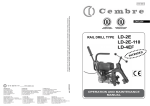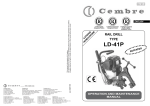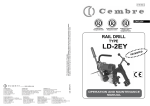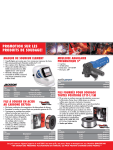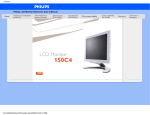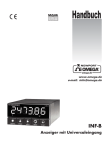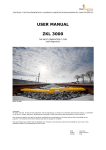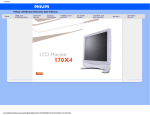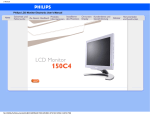Download Cembre LD-2EYGR Operating instructions
Transcript
www.cembre.com Cembre S.p.A. Via Serenissima, 9 25135 Brescia (Italia) Telefono: 030 36921 Telefax: 030 3365766 E-mail: [email protected] www.cembre.it Cembre España S.L. Calle Verano, 6 y 8 - P.I. Las Monjas 28850 Torrejón de Ardoz - Madrid (España) Teléfono: 91 4852580 Telefax: 91 4852581 E-mail: [email protected] www.cembre.es Cembre Ltd. Dunton Park Kingsbury Road, Curdworth - Sutton Coldfield West Midlands B76 9EB (Great Britain) Tel.: 01675 470440 - Fax: 01675 470220 E-mail: [email protected] www.cembre.co.uk Cembre AS Fossnes Senter N-3160 Stokke (Norway) Phone: (47) 33361765 Telefax: (47) 33361766 E-mail: [email protected] www.cembre.no Cembre S.a.r.l. 22 Avenue Ferdinand de Lesseps 91420 Morangis (France) Tél.: 01 60 49 11 90 - Fax: 01 60 49 29 10 B.P. 37 - 91421 Morangis Cédex E-mail: [email protected] www.cembre.fr Cembre GmbH Heidemannstraße 166 80939 München (Deutschland) Telefon: 089/3580676 Telefax: 089/35806777 E-mail: [email protected] www.cembre.de cod. 6261139 This manual is the property of Cembre: any reproduction is forbidden without written permission. 11 M 134 E Cembre Inc. Raritan Center Business Park 181 Fieldcrest Avenue Edison, New Jersey 08837 (USA) Tel.: (732) 225-7415 - Fax: (732) 225-7414 E-mail: [email protected] www.cembreinc.com ENGLISH Certified Quality Management System Certified Environmental Management System RAIL DRILL TYPE LD-1P-ECO D NTE E PAT OPERATION AND MAINTENANCE MANUAL WARNINGS APPENDIX “A” – Before using the drill, carefully read the instructions contained in this manual. SAVE THESE INSTRUCTIONS: this manual contains important safety and operating instructions for the drill. – STOP THE ENGINE when servicing the drill: before removing the broach cutters, spiral bits, positioning templates etc. – During operation keep hands away from the danger zone. – Always wear protective glasses and work gloves. – Avoid wearing clothes which may present a risk to personal safety. Factors which influence the number of holes that can be made according to the cutter used: – Hardness of the material to be drilled. – Thickness to be drilled. – Stability of the drill clamping and correct assembly of the drill cutters. – Suitable lubrocooling (lubrication/cooling) to keep the temperature of the cutter. low so as not to compromise the efficiency of the cutting edges, whilst at the same time facilitating the removal of swarf. – Contact time of the cutting edges of the cutter with the material to be drilled; bear in mind that the faster the hole is made the greater the efficiency. – Observance of these basic rules: 1) Commence drilling by exerting light pressure on the advance lever, progressively increasing and then relaxing it when the cutter is in the exit phase. 2) Avoid pressure surges and advance according to the diameter of the drilling diameter, to avoid scratching the material or damaging the cutting edges of the cutter. 3) Remember that a cutter with efficient cutting edges requires a lower pressure than one with which a certain number of holes have already been made. 4) When holes are made close to raised lettering on the rails, commence drilling with very light pressure until the lettering disappears, to avoid possible breakage of the cutter. LD-1PN-ECO basic drill 5) Bear in mind that when operating on very hard rails, as in the case of quality 1100 steel, it is advisable to increase the lubrocoolant flow rate. 15. RETURN TO Cembre FOR OVERHAUL LD-1P-ECO basic drill complete with railweb clamping device 1 In the case of a breakdown contact our Area Agent who will advise you on the problem and give you the necessary instructions on how to dispatch the drill to our nearest service Centre; if possible, attach a copy of the Test Certificate supplied by Cembre together with the drill or, if no other references are available, indicate the approximate purchase date and the drill serial number. 34 Qty 1 1 1 1 2 2 2 2 2 4 2 4 1 1 1 1 1 1 1 1 1 1 1 2 2 1 2 1 1 1 1 1 1 1 1 Description Spacer Blocking screw Complete bush Spring support spacer Spring M 5 self-locking nut Pin ø 8x50 cilindrical pin M5 ball dowell M 6x18 screw M 8x25 screw ø 8 elastic washer ø 4x10 cylindrical pin ø1,8x35 split pin TDB 1 termination ø1,8x35 split pin TDB 6 terminatin Split pin TDB 3 termination ø10 circlip Pin Left support shoulder Right support shoulder Blocking side plate Pin M 8x10 grub screw Handgrip Hand-wheel Blocking screw Spacer Bush Cup spring ø 2,5x16 split pin Blocking support Reference pin 1. GENERAL CHARACTERISTICS Code N° Item FIG. 32 – DBG-F2 RAIL WEB CLAMPING DEVICE 29 27 26 25 31 33 36 23 24 19 32 28 34 11 13 21 22 18 20 35 14 15 10 37 16 01 02 04 05 06 03 17 07 Drilling capacity (*): ∅ 7 ÷ 40 mm Speed without load: 270 rpm Weight: 15,7 kg Weight with DBG-F2: 18,9 kg Gear sump Recommended oil: (*) with broach cutters on thicknesses up to 50 mm with special spiral bits on thicknesses up to 45 mm 37 36 35 34 33 32 31 29 28 27 26 25 24 23 22 21 20 19 18 17 16 15 14 13 11 10 09 08 07 06 05 04 03 02 01 6001155 6002871 6001762 6001768 6001769 6180201 6001776 6760378 6340612 6900314 6900348 6650144 6760222 6140082 6001138 6140082 6001775 6140080 6001137 6040421 6001156 6001907 6001906 6001757 6001772 6340160 6380310 6001150 6001151 6001659 6001152 6520422 6140085 6001145 6001281 08 09 33 LD-1PN-ECO Combustion engine: Type: Model: Displacement: Power (SAE J1349): Fuel tank capacity: Clutch: Start: Ignition: Spark plug: Fuel: Fuel consumption: Emissions: SHELL SPIRAX S4 TXM or MOBIL SUPERMULTIGRADE 10-30-SAE or equivalents 2-stroke, horizontal shaft, single cylinder KAWASAKI TJ45E 45,4 cm3 1,4 kW (1,9 HP) / 7500 rpm 0,9 litres centrifugal with automatic intervention by rope pull solid state ignition (none breaker) NGK BPMR7A or equivalents 2% (1:50) oil/petrol mixture (see § 8) 470 g/kW.hr / 350 g/hp.hr according to "Phase 2" EPA regulation engines class V and European Directives 97/68/EC, 2001/63/EC and 2002/88/EC Acoustic Noise (Directive 2006/42/EC, annexe 1, point 1.7.4.2 letter u) – The weighted continuous acoustic pressure level equivalent A at the work place LpA is equal to ............................................................ 99,5 dB (A) – The maximum value of the weighted acoustic displacement pressure C at the work place LpCPeak is equal to ..................................... 116,3 dB (C) – The acoustic power level emitted by the machine LWA is equal to......................................................................................... 107,6 dB (A) Risks due to vibration (Directive 2006/42/EC, annexe 1, point 2.2.1.1) Tests carried out in compliance with the indications contained in UNI ENV 25349 and UNI EN 28662 part 1st Standards and under operating conditions much more severe than those normally found, certify that the weighted root mean square in frequency of the acceleration the upper limbs are exposed is 4,36 m/sec2 max. 2 2. ACCESSORIES SUPPLIED WITH THE DRILL 11 2.1) Guide bits for controlling the cooling system: for broach cutters suitable for drilling thicknesses of up to 25 mm – 1 pc PP 1, diameter 7 mm – 1 pc PP 2, diameter 8 mm for broach cutters suitable for drilling thicknesses of up to 50 mm – 1 pc PPL 1, diameter 7 mm – 1 pc PPL 2, diameter 8 mm 12 13 2.2) Spacer, type DPE, for controlling the cooling system with special spiral bits, diam. 7 ÷ 27,5 mm. 14 2.3) Adaptor, type ARE, for external cooling, to be used with the SR 5000 cooling unit. 15 2.4) Grub screw, M8x10 – 4 pcs for clamping cutters or bits on the spindle shaft. 16 17 2.5) Socket head cap screws, M6x16 – 4 pcs for securing positioning templates to the front plate. 18 2.6) Socket head cap screws, M6x25 – 4 pcs for securing special positioning templates to the front plate. 19 2.7) Range of tools: – 1 pc 5 mm allen key – 1 pc 6 mm allen key – 1 pc 4 mm allen key with handle – 1 pc sparkle plug key – 1 pc brush 20 21 22 23 2.8) Measure for mixture preparation. 24 2.9) 100 ml oil for the gear reduction. 6001209 24 6900060 23 6001731 22 6001198 21 2870261 20 6001146 19 6340160 18 6001397 17 6001195 16 6003754 15 6003755 14 6003613 13 Code N° Item (Accessories 2.1 to 2.9 are included in the “Kit of accessories”code 6001356). 2.10) Type SR5000 cooling unit. 3 32 Magnetic cap Screw M 4x8 Guard Lubricator Front plate Drilling spindle M8x10 grub screw Complete air valve Level gauge Reservoir+valve cap Starting handgrip Engine Description 1 2 1 1 1 1 2 1 1 1 1 1 Qty 6003753 12 6003752 11 6380330 10 6003612 09 6003034 08 6001166 07 6490050 06 6001941 05 6360480 04 6001176 03 6001428 02 6001950 01 Code N° Item Air cleaner element 1 Spark plug 1 Handle 1 Complete handgrip 1 Cap 1 Accelerator lever 1 Carriage handle 1 Complete spindle lever 1 O-ring 1 Lever release pawl 1 Complete cooling connection 1 Body 1 Description Qty 3. ACCESSORIES TO BE ORDERED SEPARATELY 3.1) DBG-F2 device (*) with moving arm for clamping the drill to the rail web and track fittings, complete with the following end pieces: – TDB 1: for switch blades and compound frogs. – TDB 3: for repairing (adjusting) existing holes on rails for subsequent application of electrical connections and for additional special applications. – TDB 6: standard end piece for rails and stock rails. 10 09 (*) Supplied with drilling machine ref. LD-1P-ECO 08 07 06 TDB 1 05 TDB 6 TDB 3 3.2) DBG-LF2 device with moving arm complete with TDB 7 end piece for clamping the drill to girder rails and for additional special applications. 04 03 02 TDB 7 3.3) DBSN device for clamping the drill to flange rails, for use in conjunction with the MPAF templates. Using this device the rail drill can remain clamped in the drilling position even when trains pass over it. 01 The guarantee is void if parts used are not Cembre original spares. When ordering spare parts always give the following information: - spare part code - spare part description - drilling machine model - drilling machine serial number 3.4) “VAL LD” metal case for storing the drill complete with the DBG-F2 device, VAL MPA tool case and DBSN devide. 3.4.1) “VAL LD-L” metal case for storing the drill complete with the DBG-LF2 device, VAL MPA tool case and DBSN devide. FIG. 31 – DRILL ASSEMBLY 31 4 13.2.6) Checking of screws – Check and re-tighten all screws where necessary. 3.5) Templates for positioning the drill on the rails and stock rails to enable drilling to be carried out according to the provisions of railway boards standards: e.g.: – MPAF UIC54 on DRILLING AXIS of 54E1 rail – MPAF UIC60 on DRILLING AXIS of 60E1 rail 13.3) SPECIAL MAINTENANCE OF THE DRILL The special maintenance operations require the intervention of qualified personnel only, please contact Cembre (See § 15). • Note: Contact Cembre for selection of specific application accessories (e.g.: positioning templates for other rail profiles). 13.4) STORING THE DRILL FOR LONG PERIODS – – – – – Completely empty the fuel tank. Start the engine and let it run until it stops, so that all fuel is exhausted from the machine. Remove the spark plug. Pour 3-5 cm3 of oil into the cylinder. Repeatedly pull gently on the starting rope so that the dispersion of the oil in the cylinder is achieved reinstall the spark plug. – With a clean cloth wetted with engine oil, than clean all metal parts of the machine. – Store the drilling machine in its appropriate case or in a dry environment, protecting it against accidental damage and dust. 3.6) MPAU universal positioning template suitable both for repairing existing holes on various fittings, and for drilling disused rails. 3.7) SPA positioning plates for drilling rail heads with a centre-to-centre distance established in the Railway boards standards, without the need for marking out; for use in conjunction with the MPAF ... positioning templates. 14. WARNINGS 14.1) Regularly check for correct tightening (torque) of the fixing screws of the drill cutters and the positioning templates. 14.2) Avoid pressure jolts on the advance lever during drilling. 14.3) Always make sure that drilling swarf is properly removed before starting to drill a new hole. 14.4) Incomplete clamping of the drill on the rail to be drilled may lead to the breakage or accelerated wear of cutters and damage to the spindle shaft bearings. 14.5) If it is necessary to operate the drill without the cutter inserted, remove the locking grub screws from the spindle shaft. 14.6) Avoid leaving the SR 5000 tank under pressure and exposed to sunlight for long periods of time. 14.7) Should the DBG-F2 clamping device be removed make sure, by reassembling it, the two blocking screws are firmily fastened. 3.8) MRF clamp to be applied as a reference to the head of rails for use, in conjunction with the SPA ... connecting plates, for in-line drilling of the rail heads, with established centre-to-centre distance. 3.9) VAL MPA metal box suitable for accommodating accessories 3.5 - 3.11. 5 30 3.10) Broach cutters 13.2.4) Spark plug cleaning (Ref. to Fig. 29) – Disconnect the spark plug lead and with a spark plug key remove the spark plug. – Clean the electrode, taking care not to damage the insulation. – Check and adjust if necessary the electrode gap. (0.6 mm - 0.7 mm). – Install and tighten the spark plug to 14 Nm, then connect the spark plug lead. – In case of plug replacement, use type NGK BPMR7A or equivalent: BOSCH WSR5F / DENSO W22MPR-U / CHAMPION RCJ6Y. BROACH CUTTERS FOR RAILS IN STEEL QUALITY 700-900-1100 (UIC 860.0) Ø mm 13,5 14 15 16 17 18 19 20 21 22 23 24 25 26 27 28 29 30 31 32 33 34 35 36 37 38 39 40 FIG. 29 – SPARK PLUG CLEANING Spark arrester 13.2.5) Spark arrester cleaning (Ref. to Fig. 30) – Remove the spark arrester from the exhaust opening. – Clean deposits from the spark arrester screen by brushing it. – Relocate the spark arrester. FIG. 30 – SPARK ARRESTER CLEANING SHORT RANGE Broach cutter A A A A A A A A A A A A A A A A A A A A A A A A A A A A 135 140 * 150 * 160 170 180 190 200 210 220 230 240 250 260 270 280 290 300 310 * 320 330 340 * 350 * 360 * 370 * 380 * 390 * 400 * Guide bit LONG RANGE (L max = 88mm) Broach cutter Guide bit Ref. PP 1 Ref. PP 2 MAX DRILLING THICKNESS 25 mm A A A A A A A A A A A A A A A A A A A A A A A A A 160L 170L 180L 190L 200L * 210L 220L 230L 240L 250L 260L 270L * 280L 290L * 300L 310L * 320L 330L 340L * 350L * 360L * 370L * 380L * 390L * 400L * Ref. PPL 1 Ref. PPL 2 * Contact Cembre for availability of these broach cutters. Every 50 hours of operating MAX DRILLING THICKNESS 50 mm Broach cutter resharpening must be carried out in compliance with appropriate methods of operation which provide the best result. 29 6 3.11) Spiral bits 13.2) ROUTINE ENGINE MAINTENANCE 13.2.1) Fuel Tank Cap A breather passage is incorporated in the tank cap. If this passage is clogged, the fuel will not flow into the carburetor, causing problems with starting or running the engine. At the same time, make sure that the base of the breather assembly is fitted firmly into the groove inside the tank cap, as shown. ø h APED... FIG. 1 L max APE... Breather Gancio assembly 13.2.2) Fuel filter cleaning (Ref. to Fig. 27) – Pick the grommet out of the fuel tank and remove the fuel filter assembly from the fuel tank together with the grommet and the fuel tube to keep dust, entering from the fuel filter. – Clean the fuel filter assembly in a bath of high flash-point solvent. – Dry the fuel filter assembly before reassemble. Improper use of solvents can result in fire or explosion. ø FIG. 2 Breather Sfiato passage Breather Fuel tank Membrana Serbatoio Every 20 hours of operating L max Tank cap Tappo SPECIAL SPIRAL BITS FOR RAILS IN STEEL QUALITY 700 - 900 - 1100 (UIC 860.0) PE 70 PE 71 PE 80 PE 85 PE 90 PE 95 PE 100 PE 110 PE 120 PE 130AR PE 135AR 76 72 1,2 APED 70 APED 80 76 1,4 APE 90 APE 95 APE 100 APE 110 APE 120 1,6 APED 130 APED 135/165 Ø mm 14 16 17 17,5 18 19 2 21 22 24 27,5 1 PE 140 PE 160 PE 170AR PE 175 PE 180 PE 190AR PE 210AR PE 220 PE 240AR PE 275AR L h max mm mm 76 Adaptor ref. 1,6 APED 135/165 88 85 special high quality spiral bit. 7 7,1 8 8,5 9 1 9,5 10 11 12 13 13,5 Adaptor ref. Spiral Bit ref. (*) (*) PE... AR: Ø mm L h max mm mm Figure Figure Tube Spiral Bit ref. (*) 88 Fuel tank Transparent overflow tube Filter FIG. 27 – FUEL FILTER CLEANING – Special spiral bits in the PE range allow automatic cooling by means of the SR 5000 unit supplied with the drilling machine. – All spiral bits in the PE range allow drilling of thicknesses up to 45 mm. 13.2.3) Air filter cleaning (Ref. to Fig. 28) – Manually remove the holding screws of the air cleaner cup. – Remove the filter element. – Wash the filter element in detergent and water and dry it thoroughly. – Reassemble all parts. Operating in dusty condition may require more frequent maintenance than above. Do not operate the engine with air filter removed. The drilling bits indicated in the tables guarantee optimum results. For bits of other types, check the dimensional compatibility (particularly the size of the attachment and the length). 3.12) LR2 BIODEGRADABLE LUBROCOOLANT 3 litre container to be used in a 5-10 % solution, for optimum operation of broach cutters and spiral bits. 3.13) LR3 ANTIFREEZE CONCENTRATE 3 litre added to the lubrocoolant mixture in the right concentration will maintain the lubrocoolant mixture fluid in negative temperature conditions. Grommet 3l FIG. 28 – AIR FILTER CLEANING 7 28 13.1.2) Removal of metal residues from the crankcase When the drill is positioned as shown in Fig. 26c unscrew the cap with magnetic insert (24) on which any metal residues present in the oil will have collected. Carefully clean the magnetic insert with a clean rag and screw it back in to the appropriate housing. 4. COOLANT UNIT TYPE SR5000 24 FIG. 26c – REMOVAL OF METALLIC WASTE Every 50 hours of operation 13.1.3) Checking of screws. – Check and re-tighten all screws where necessary. 13.1.4) Lubrication (Ref. to Figs. 31 and 32) – Lubricate the spindle support housing by means of the appropriate lubricator (21), the screw (07) of the DBG-F2 clamping device. 13.1.5) Coolant filter cleaning (Ref. to Fig. 26d) The coolant circuit of the drilling machine is provided with anti-impurity filter; should an evident decrease of the flow of the lubrocoolant occur, it could be necessary to clean the filter in the following way: – Using a 14 mm key, unscrew the coupling (02). – Extract the filter and clean it carefully. – Reassemble the filter into the coupling (02) as shown in the Fig. 26d and fully tighten the coupling. The type SR5000 coolant unit consists of a tank complete with tube and maximum pressure valve (01) fitted with a pump device for pressurisation, which must be connected to the attachment (35) on the drill by means of its quick-coupling (03). The delivery and shut-off of the lubrocoolant are controlled automatically when drilling with a broach cutter from the position of the guide bit; when drilling with a spiral bit, delivery and shut-off of the fluid must be effected manually by operating the tap (02). The use of the lubrocoolant supplied by Cembre, in the recommended concentrations, guarantees optimum use of the drilling tools. Consumption of the lubrocoolant depends both on the variable degree of opening of the tap (02) and the inner pressure of the tank: it is therefore advisable to open the tap a little when the tank is at maximum pressure, while it must be fully opened when the pressure in the tank is low. When using the coolant system, pay careful attention to the instructions on the tank label. Warning: • When the tank is not under pressure, check that the bush on the maximum pressure valve is screwed right down. • To fill tank with lubrocoolant, turn handle anticlockwise approximately 2 turns to release handle locking mechanism. Remove handle/piston assembly from tank. Detail of the max pressure valve 17 – Vent valve 35 – Attachment valve 01 – Tank complete with tube and max. pressure valve 02 – Tap 03 – Quick-coupling 01 anti-impurity filter 02 02 FIG. 26d – COOLANT FILTER CLEANING 27 FIG. 3 – COOLING UNIT 8 03 35 17 • The rail drill is equipped with the cooling attachment valve (35) and a vent valve (17) which are located as shown (Fig. 3). If under certain operating circumstances they need to be interchanged, proceed as follows: – With a 17 mm hexagonal spanner, unscrew the vent valve from its seat. – Using the 4 mm Allen key provided with the drill, remove the appropriate cooling valve from its seat and fit into the vent valve seat. – Fit the vent valve into the removed coolant valve seat. 13. MAINTENANCE Before you service or remove parts, stop the engine and allow it to cool. Always remove the spark plug cap from spark plug when servicing the engine to prevent accidental starting. • When temperatures fall below 0° C – – – – the lubrocoolant may freeze which could cause damage to the seals contained in the drill cooling system. It is therefore advisable, when storing the drilling machine, to empty the lubrocoolant system completely. Proceed as follows (Fig. 4): Disconnect the quick coupling (03) from the coolant attachment (35) on the drilling machine. Tilt the machine so that the coolant attachment is at its lowest point allowing for natural drainage. Operate the advance lever (36) to advance and retract the drilling spindle. Gently shake the machine to establish expulsion of all fluid. After the first 10 operating hours, proceed with oil sump change, as follows (Ref. to Fig. 26a and 26b): – Remove the cap with the magnetic insert (24). – Remove the oil filler cap (08). – Make sure that all the oil comes out by slightly tilting the drilling machine in order to make the operation easier. 08 – Clean the cap (24) (see § 13.1.2). – Reassemble the cap . – Fill up the oil sump to the level indicator (see § 13.1.1) using the oil supplied with the drilling machine; it will be necessary to use about 100 ml. FIG. 26a – Replace the oil filler cap (08). FIG. 4 4.1) ARE adapter For use with the SR5000 cooling unit. The ARE adapter is inserted in the quick-coupling of the tank tube (Ref. to Fig. 5). May be used to provide manual external cooling when cutters are used to enlarge existing holes or when using spiral bits not designed for automatic cooling. If necessary, the ARE adapter can also be used to clean various parts of the drill, by means of the lubrocoolant pressure jet, e.g. parts such as the tool clamping seat in the spindle shaft, seats for the jig fixing screws, etc. ARE adapter Ensure that disposal of used oil is in accordance with current legislation. 13.1) ORDINARY MAINTENANCE OF THE MACHINE Every 20 hours of operation 13.1.1) Topping up oil (Ref. to Fig. 26a and 26b) With the drill switched off and placed on a flat surface, check the oil level in the crankcase by looking through the transparent inspection cover (16). The level must be approximately half way up the cover; if the level is low, top up the oil by unscrewing the cap (08) at the top of the crankcase and adding the quantity of oil required. Only use the oil grade recommended in § 1. Never use regenerated or used oil. The oil must be clean. FIG. 26b FIG. 5 – ARE ADAPTER 9 16 26 24 5. SPINDLE ADVANCE LEVER 12. STORING THE DRILL When the work has been completed, store the drill by proceeding as follows: 12.1) Depressurise the tank of the SR5000 coolant unit (see § 4), close the tap (02) on the tube from the tank and disconnect the quick-coupling (03). 12.2) Carefully clean the drill, particularly in the spindle area, removing machining waste (swarf, etc.) and any deposits of lubricating coolant. The spindle is advanced by moving the lever (36) (See Fig. 6a). The lever is fitted with a release pawl (39) which, when pressed, renders it independent of the hub and hence the spindle; the operator can therefore easily vary the angular position of the lever without movement of the spindle (Fig. 6b). 12.3) Fully withdraw the spindle. 12.4) Place the drill and the SR5000 cooling unit in a sealed place free from dust, moisture and the risk of accidental impact. otection Cembre recommends the use of the VAL LD metal case designed For better protection ose (see § 3.2), which enables e for this purpose the drill to be located and to be locked in the case by means ans of DBG-F2 clamping device. A suitable suita housing is also provided in this VAL LD for the VAL MPA box containing the most commonly used accessories. a FIG. 6 6a - Moving the lever (36) towards the operator; corresponding advance of the spindle. DBSN VAL MPA 6b - With the release pawl (39) pressed, the lever is released from its hub and can repeat the previous travel without the spindle moving. DRILL 6c - With the hub released, moving the lever towards the operator causes a corresponding advance of the spindle. FIG. 7 5.1) Adjustment of the advance lever The movement of the lever must never be loose. For adjustment proceed to tighten it by loading the cup springs by means of the associated self-locking nut, after removing the protective cap (see Fig. 7). VAL LD FIG. 25 STORAGE CASE 25 10 02 6. PREPARING THE DRILL For clarity the drilling machine is not shown. STOP THE ENGINE when servicing the drill: before removing the broach cutters, spiral bits, positioning templates etc. 6.1) Assembling broach cutters (Ref. to Figs. 8-11). 6.1.1) Insert the guide bit in the cutter from the side of the spigot. 6.1.2) Using the lever (36), position the spindle shaft (07) so that both grub screws (18) become accessible and sufficient space is provided to insert the cutter; if necessary rotate the spindle shaft manually and sufficiently by inserting the 4 mm allen key in the appropriate intermediate gear housing (33) in the crankcase of the drill (see Fig. 11). 6.1.3) Insert the cutter in the spindle shaft so that the two engaging dogs on the cutter spigot line up with the grub screws (18). 6.1.4) Clamp the cutter by fully tightening the grub screws using the 4 mm allen key. 6.1.5) Check that the guide bit slides freely by applying slight pressure on it. Engaging dogs Origin of the distances Short type broach cutter Maximum drilling thickness: 25 mm 18 Guide bit PP... 07 02 Origin of the distances Guide bit PPL ... Long type broach cutter Maximum drilling thickness: 50 mm FIG. 8 – ASSEMBLING BROACH CUTTERS 6.2) Assembling special spiral bits (Ref. to Figs. 9 - 11) 6.2.1) Using the advance lever, position the spindle shaft so that both grub screws become accessible and sufficient space is provided to insert the spiral bit; if necessary rotate the spindle shaft manually and sufficiently by inserting the 4 mm male hexagon key in the appropriate intermediate gear housing (33) in the crank-case of the drill (see Fig. 11). 11 FIG. 24 – POSITIONING 24 11.2) Drilling in line with the rail heads (Ref. to Figs. 23-24) 11.2.1) Fit the MPAF... positioning template corresponding to the rail to be drilled (see § 7.3). 11.2.2) Fit the MRF clamp on the head of the rail, keeping it in contact with the rail head at a point which defines the origin of the drilling centres, by locking it in position with the lever. The lever is provided with a return pushbutton for moving in any direction after locking. (See Fig. 23) 11.2.3) Insert the SPA... positioning plate so that the curved part is facing upwards. 11.2.4) Insert the locking pin (02) in one of the two holes of the connection plate. 11.2.5) With the spindle fully withdrawn, position the drill on the rail close to the MRF clamp, without locking the spindle. 11.2.6) Slide the drill so that: – the curved end of the SPA... plate is flush against the MRF clamp on the side identifying the origin of the distances. – the MPAF... positioning template is flush against the locking bolt (02) (see Fig. 24). 11.2.7) Clamp the drill in this position by tightening the handwheel fully and commence drilling (see § 10.1). 11.2.8) To drill the second hole in the rail, repeat operations 11.2.6 - 11.2.7 with the locking pin (02) inserted in the second hole of the SPA... plate. 6.2.2) Insert into the spindle shaft, the DPE spacer required to activate the cooling device. If necessary to use APE... adapter (see pag. 7) the bit must first be fitted in the corresponding APE adapter and locked with the appropriate grub screw. Then the DPE spacer may be inserted. Note: Adapters type APED… do not require use of DPE spacer. 6.2.3) Insert the bit-spacer unit in the spindle shaft so that the two engaging dogs on the bit spigot line up with the grub screws. Press the bit-spacer unit home against the inner seat of the spindle: this will enable the DPE spacer to open the cooling circuit (see Fig. 10). 6.2.4) Clamp the bit by fully tightening the two grub screws (18) using the 4 mm male allen key. APE ... 18 Bits PE ... (e.g. PE 95) DPE * 07 Bits PE ... (e.g. PE 190) DPE * use only for APE..., not required for APED... FIG. 9 – ASSEMBLING SPIRAL BITS FIG.10 – ASSEMBLING BIT-SPACER UNIT 71 33 FIG. 11 – MANUAL SPINDLE ROTATION FIG. 23 – ASSEMBLY OF THE MRF CLAMP 23 12 7. DRILL TYPE LD-1P-ECO 11. SPA... POSITIONING PLATE The reference LD-1P-ECO relates to the basic drill complete with the moving arm device type DBG-F2 for clamping it to the rail web and the track fittings (Ref. to Fig. 12). The DBG-F2 device consists of: – Clamping unit – Type TDB 1 termination – Type TDB 3 termination – Type TDB 6 termination – Socket head cap screws M 8x25 (2 pcs) – Spring washers (4 pcs) – Reference pin 11.1) Instruction for drilling close to rail heads 02 03 FIG. 21 11.1.1) Fit the MPAF... positioning template corresponding to the rail to be drilled (see § 7.3). 11.1.2) Insert the SPA... positioning plate (03) relating to the rail to be drilled in the appropriate housing (see Fig. 21). 11.1.3) Insert the locking pin (02) in one of the two holes of the connection plate. 11.1.4) With the spindle fully withdrawn position the drill close to the rail head without clamping it. 11.1.5) Slide the drill so that: – the curved end of the SPA... plate is flush against the rail head. – the MPAF... positioning template is flush against the locking bolt (02). 11.1.6) Clamp the drill in this position by tightening the handwheel fully, and commence drilling (see § 8.1). 11.1.7) To drill the second hole in the rail, repeat operations 11.1.5 - 6 with the locking pin (02) inserted in the second hole of the SPA... plate. For clarity the drilling machine is not shown. TDB 3 refere reference ence pin n M 8x25 screws and spring washers 02 TDB 6 TDB 1 FIG. 22 – POSITIONING FIG. 12 – DRILL LD-1P-ECO 13 22 7.1) Assemble of the terminations of the DBG-F2 device with moving arm for clamping the drill to the rail web and track fittings. The terminations TDB 1, TDB 6 and TDB 3 of the DBG-F2 device, with moving arm, have been designed for adaptation to the different operating conditions on rails and track fittings; their assembly is shown in Fig. 13. • When assembling the type TDB 3 termination remember that the positioning pawl must be down in relation to the bolt. • When disassembling the TDB 6 termination, please bear in mind that after removing the pivot, it is necessary to slide the complete assembly away downwards, being careful not to act on the holding plate. • Over-advancing the spindle after drilling must be avoided using the TDB 1 and TDB3 terminations. Approach Start drilling with discharge of lubrocoolant Drilling holding plate Finish drilling with removal of swarf and switching off of lubrocoolant FIG. 19 – COOLANT OPERATION WITH BROACH CUTTER 10.3) Drill fitted with special spiral bit Follow the sequence described in § 10.1, taking care to position the drill on the rail by keeping the spindle fully withdrawn. Bear in mind that the cooling circuit, instead of being automatically opened and closed by the guide bit, is kept open at all times by the DPE spacer fitted on the spigot of the spiral bit; it must therefore be activated, by opening the tap (02), before starting to drill, then switched off after drilling by closing the tap. Termination TDB 1 for switch blades and compound frogs Termination TDB 6 for rails and stock rails Termination TDB 3 for enlarging existing holes on rails inherent in the application of electrical connections and for additional special applications. Seats to be used for special applications. FIG. 20a PE 70 - PE 165 spiral bits (drilling diameters from 7 to 16.5 mm) * use only for APE..., * not required for APED... FIG. 20b PE 170 - PE 275 spiral bits (drilling diameters from 17 to 22 mm) positioning pawl pointing downwards FIG.13 – ASSEMBLY OF THE TERMINATIONS FIG. 20 – COOLANT OPERATION WITH SPIRAL BIT 21 7.2) Assembly of the DBG-F2 clamping device on the drill The DBG-F2 clamping device is fitted to the front plate of the drill, centred by means of the reference pin supplied and secured with the two socket head cap screws M8x25 (35) also supplied. The assembly is illustrated in Fig. 14. 14 DBG-F2 Clamp FIG. 14 – ASSEMBLY OF THE “DBG-F2” CLAMP 35 10.1.4) Start the engine following instructions to § 9. 10.1.5) Proceed to drill by initially applying light pressure on the lever (36), increasing the pressure progressively, avoiding jolts, and finally relieving the pressure in the exit phase. When drilling close to raised letters on the rail the initial pressure must be extremely light until the lettering disappears, otherwise the cutter may be damaged. 10.1.6) The guide bit will enable the lubrocoolant to be discharged throughout the drilling process. 10.1.7) When the drilling has been completed, fully retract the spindle, stop the engine by positioning the relevant switch to "OFF" position, and make sure that drilling swarf is removed before recommencing drilling. 10.1.8) After drilling, it is advisable to remove all swarf from the tool and spindle area. 10.2) Drill fitted with “long” type broach cutter (for drilling thicknesses of up to 50 mm). Follow the sequence described in § 10.1, taking care to position the drill on the rail by keeping the spindle fully withdrawn. Drilling machine front plate 7.3) Assembly of the positioning templates (Ref. to Fig. 15) 11 7.3.1) The type MPAF.. and MPAU positioning templates are secured to the front plate (04) of the drill by means of the two socket head cap screws M 6x16 supplied. 36 02 reference pin 35 04 39 MPAU screws M6x16 MPAF... FIG. 15 – ASSEMBLY OF THE POSITIONING TEMPLATES FIG. 18 – DRILLING 15 20 7.4) Clamping to the rail web (Ref. to Fig. 16) 10. DRILLING Before operating the drill, activate the coolant system (§ 4) 10.1) Drill fitted with “short” type broach cutter (for drilling thicknesses up to 25 mm). The drilling sequence may be started with the drill fitted with the broach cutter (§ 6.1), positioning jig (§ 7.2), the drill being clamped to the rail (§ 7.3), as follows: 10.1.1) Connect the female quick-coupling of the SR 5000 cooling system to the male attachment (35) on the drill. 10.1.2) Open the tap (02) fitted on the tank tube. 10.1.3) Using the lever (36) bring the guide bit almost in contact with the rail (Fig. 17a); keeping the release pawl (39) pressed, release the lever from its cup and return it to the initial position (Fig. 17b), which will enable the travel of the lever (36) to be used in the most advantageous way. Fig. 17a Fig. 17b 36 The drill has a rapid rail engagement/release mechanism and specially shaped positioning templates for each rail type which facilitate precise and certain location of the part to be drilled. To fully exploit the special features of the engagement device, we recommend calibrating it to the rail type to be drilled as follows: 7.4.1) Withdraw the spindle shaft (07) completely by means of the lever (36). 7.4.2) Insert the threaded bush (39) of screw (11) into its seat (A) in the mobile arm (17) (see detail in Fig. 16); use the hand-wheel (12) to completely open the mobile arm. 7.4.3) Place the drill on the rail at the point to be drilled and clamp it by tightening the hand-wheel (12) fully down: the positioning template will automatically position the cutter or drill bit in line with the designated axis; if precise positioning is necessary to the longitudinal rail axis, use the reference pin (01). 7.4.4) For rapid drill release, simply back-off the handwheel (12) by approximately two complete turns, and while supporting the drill by its grip (09), pull the handwheel towards you. The threaded bush (39) will disengage the seat (A) in the mobile arm (17) which will open automatically, freeing the drill. In this way, the operator can rapidly remove the machine from the track in case of danger or move on to drill another hole. Thus, the next track engagement operation will be considerably simplified: after positioning the drill at the point to be drilled, simply push the handwheel forwards so that the threaded bush engages the seat (A) of the mobile arm. Now, a few turns on the hand-wheel (12) will be sufficient to engage the drill correctly on the rail. 09 36 12 11 ➟ 17 39 39 A 01 17 11 39 07 FIG. 17 – DRILLING FIG. 16 – POSITIONING OF THE DRILL 19 16 ➟ Fig. 17c 17 9.3) Make sure that the accelerator lever is in position "0". Only with a cool engine, set the ‘choke lever’ upwards, on the left side in starting position (Fig. c); when engine is warm or in case of high ambient temperature, set this lever downward in working position (Fig f). 9.4) Pull sharply on the starting rope and then release slowly; the 8. FUEL PREPARATION WARNING engine before ignition, may require more than one operation (Fig. d). - Petrol is extremely flammable and explosive. - DO NOT SMOKE. - Refuel in a well ventilated area away from flame or sparks. - Stop engine and allow it to cool before refueling. - Exhaust gas contains carbon monoxide, an odourless and deadly poison. - Do not run engine in an enclosed area. - To avoid a serious burn, do not touch a hot engine or exhaust. - The engine becomes hot during operation. The rail drill features a two-stroke petrol engine run on a 2% (1:50) oil/petrol mixture; a calibrated measuring cylinder is supplied for this purpose. Always use engine oil for two-stroke engines. This engine is certified to operate on unleaded regular grade petrol only. A minimum of 89 octane on the antiknock index is recommended. Warning: do not remove or alter in any way, the valve in the cap of the fuel tank. Do not over-extend the starting rope and always release it slowly once the motor is running; a sudden release could damage the b) starting system. If the engine does not start, do not repeatedly pull the starting rope with the ‘choke lever’ in start position. This could create a fuel excess in the cylinder and make ignition more difficult. In this case, set the lever in working position and repeat the starting operation. Once started change the speed of the engine twice to allow the remaining air to leave the carburettor. 9.5) Just after starting, accelerate the engine gradually before starting any activity, then set the accelerator lever in "1" position (Fig. e) till the ‘choke lever’ automatically returns, then set it again in "0" position. 9.6) Allow the engine to warm up for approximately 2 minutes then set the accelerator lever in "1" position of maximum acceleration and start to drill. 9.7) To stop the engine move the “ON/OFF” switch to the “OFF” position. 9.8) Idling speed adjustment: if necessary, adjust the idling screw (Fig. f), so that the engine maintains a stable idling speed (2800 rpm). 9.9) Carburettor adjustment The carburettor has been factory previously adjusted. The control system of the gas emissions applied to this motor consists of a carburettor and ignition system which guarantee the best results. The carburettor is so adjusted to provide the air/fuel mixture required d) to achieve low consumptions and low emissions of injurious gas. : speed increases : speed decreases The engine will perform at its optimum after a “running-in” period of approximately 200 drilling operations. 9. STARTING THE ENGINE Before starting the engine, make sure that: - the spindle is completely retracted (see § 5). - the accelerator control lever is completely closed (0). c) 9.1) Move engine "ON/OFF" switch to the “ON” position (Fig. a). 9.2) Repeatedly operate the fuel pump until fuel flows through the overflow pipe (Fig. b). f) a) 17 18 e)


















